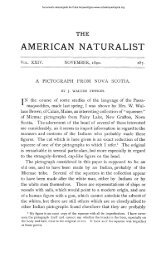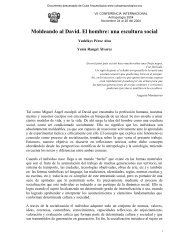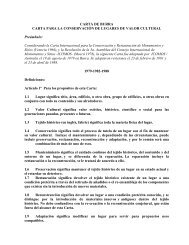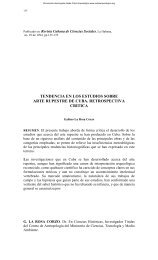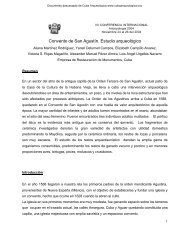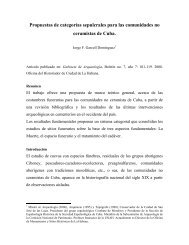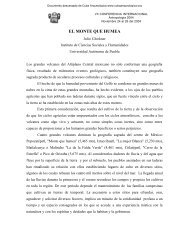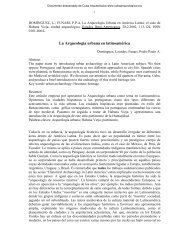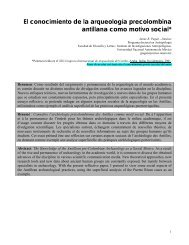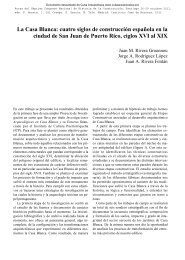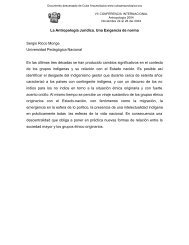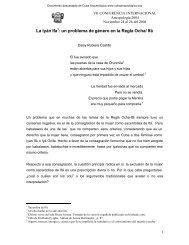The Gunboat Baire - Cuba Arqueológica
The Gunboat Baire - Cuba Arqueológica
The Gunboat Baire - Cuba Arqueológica
Create successful ePaper yourself
Turn your PDF publications into a flip-book with our unique Google optimized e-Paper software.
Published in:<br />
Documento descargado de <strong>Cuba</strong> <strong>Arqueológica</strong> www.cubaarqueologica.org<br />
<strong>The</strong> gunboat <strong>Baire</strong> (1906-1943).<br />
Brief history of a ship of the <strong>Cuba</strong>n Navy.<br />
By Alfredo E. Figueredo<br />
http://www.histarmar.com.ar/ArmadasExtranjeras/<strong>Cuba</strong>/ElCanionro<strong>Baire</strong>.htm<br />
(septiembre, 2010).<br />
<strong>The</strong> Coast Guard Service of <strong>Cuba</strong> was created in 1899 by the Unites States<br />
provisional government. <strong>The</strong> head of the same would be the Director of Customs of<br />
<strong>Cuba</strong>, Major Tasker H. Bliss. This Service, at the beginning, was formed by four former<br />
Spanish auxiliary gunboats, five coastal tugboats ordered from the United States, and<br />
some yachts and ships purchased from the domestic merchant marine and from abroad. 1<br />
<strong>The</strong> first government of an independent <strong>Cuba</strong> published on 7 June 1905 in the<br />
Gaceta Oficial an invitation for bids for the Coast Guard Service in order to acquire a<br />
steamship with twin screws, displacing 500 tons, at a price not to exceed $ 115,000.00.<br />
<strong>The</strong> house of G. Hempel, in the person of Pablo Deeher, representatives of the famous<br />
shipyard J. W. Klawitter of Danzig, German Empire, signed a contract for that ship with
Documento descargado de <strong>Cuba</strong> <strong>Arqueológica</strong> www.cubaarqueologica.org<br />
the Secretariat of Finances in December 1905. On 4 February 1906, said construction<br />
was approved by Decree 126 of the Secretariat of Finances. 2<br />
In 1906, <strong>Baire</strong> was launched in Danzig, German Empire. Pursuant to the<br />
contract, she displaced 500 tons; measured 196 x 23 x 9 feet. She had bunkerage for 120<br />
tons of coal, and her engines generated 1,200 horsepower with Babcock boilers, giving<br />
her a speed of 14 knots. <strong>The</strong> minimum draft was 7 feet, and the maximum was 10 feet.<br />
She mounted two guns of 5.7 cm. (6 lbs.), two guns of 4.7 cm. (3 lbs.), and a Browning<br />
.50 caliber machine gun. Her complement was 11 officers, 2 warrant officers, and 63<br />
sailors. She made the trip from the Baltic Sea to Havana without any complications. 3<br />
<strong>The</strong> elegant design of <strong>Baire</strong> may be appreciated in the photograph accompanying<br />
this article, as well as the rambow, which was then in fashion. <strong>The</strong> venerable third-class<br />
cruiser <strong>Cuba</strong>, before its reconstruction, also had a similar rambow.<br />
At the beginning, the new gunboat, first of her name, was destined to patrol the<br />
coasts from Cape Maisí to Santiago de <strong>Cuba</strong>. When in 1911 the Coast Guard Service<br />
was incorporated to the new Navy, <strong>Baire</strong> continued with the same coast guard duty until<br />
1920. In 1917, she was reconstructed in the United States (Charleston Navy Yard) due to<br />
the First World War, and her original armament was changed for another of United States<br />
provenience. As of that date, she mounted four guns of 7.62 cm. (12 lbs.) and two guns<br />
of 3.7 cm. (1 lb.), all new. Apart from the .50 caliber Browning, another machine gun<br />
was added, a .30 caliber Browning. 4<br />
After her reconstruction, and during the First World War, <strong>Baire</strong> was part of the<br />
“Mobile Force” of the Navy, based in Havana, along with the third-class cruiser <strong>Cuba</strong>,<br />
the cruise-schoolship Patria, and four submarine chasers. 5<br />
On 23 April 1923, <strong>Baire</strong>, under her captain Enrique Ferrer, transferred the mortal<br />
remains of Mariana Grajales from Kingston, Jamaica, where they were buried, to<br />
Santiago de <strong>Cuba</strong>. 6
Documento descargado de <strong>Cuba</strong> <strong>Arqueológica</strong> www.cubaarqueologica.org<br />
In October, 1926, a hurricane sank the gunboat Hatuey in the port of Havana.<br />
This gunboat served the functions of a Presidential Yacht. Even though in 1929 the yacht<br />
Jamaica, renamed as Juan Bruno Zayas was acquired to serve as a Yacht for the chief<br />
executive, until the decade of the 1940’s <strong>Baire</strong> was also sometimes called to serve the<br />
President in that way. 7<br />
During the month of August, 1931, General Mario García Menocal and Colonel<br />
Carlos Mendieta Montefur, active in the opposition to president Machado, convinced<br />
Corvette Captain Juan E. Rivera, who was at that time commanding <strong>Baire</strong>, to take them<br />
from Río Verde, north coast of Pinar del Río, to Oriente. This became known to<br />
Machado, who separated Rivera from the Navy, and arrested Menocal and Mendieta at<br />
the same Embarcadero de Río Verde. <strong>The</strong> gunboat Oscar Fernández Quevedo took the<br />
two conspirators to Havana, escorted by <strong>Baire</strong> under another captain. 8<br />
<strong>Baire</strong> visited Tampa from the 10 to the 14 February, 1936, by reason of the<br />
Annual Gasparilla Carnival and the Florida Fair, part of the Jubilee of the Tobacco<br />
Industry of that city. Some fights were reported at the dock between the crew of <strong>Baire</strong><br />
and “<strong>Cuba</strong>n political refugees residing in Florida”. According to Lieutenant George H.<br />
Bahm, USN of the U.S.S. Schenk (DD-159), which was also docked in Tampa in front of<br />
<strong>Baire</strong>, these “political refugees” were followers of the recently deposed president<br />
Machado, and had as their objective “seizing the gunboat”. This attempt failed. 9<br />
In 1940, the speed of <strong>Baire</strong> was limited to 10 knots; in the 1941 edition of Jane’s<br />
Fighting Ships, <strong>Baire</strong> still appears as a Presidential Yacht. In 1943, the history of our<br />
handsome ship ends, when, due to the Second World War, an inspection by Commander<br />
C. A. Griffiths, USN (Ret.) recommends that, because of the poor condition of her hull<br />
and machinery, repairs not be continued, and she should be retired from active service<br />
immediately. <strong>The</strong> guns, the machinery, and the equipment may be salvaged. 10
Documento descargado de <strong>Cuba</strong> <strong>Arqueológica</strong> www.cubaarqueologica.org<br />
In 1956, a submarine chaser of the United States PC-class was acquired by the<br />
Navy from the Honduran merchant marine. She was given the number P.E. 203, and the<br />
name of the old <strong>Baire</strong>. This was the second ship so called in <strong>Cuba</strong>n service. 11<br />
NOTES<br />
1 Balbis, Historia; Gálvez Aguilera, Marina de Guerra.<br />
2 Balbis, op. cit.<br />
3 loc. cit.; Wright, <strong>Cuba</strong>n Navy; Parkes and Pendergast, Jane’s.<br />
4 Gálvez Aguilera, op. cit.; Wright, <strong>Cuba</strong>n Navy; Parkes and Pendergast, Jane’s.<br />
5 Scheina, Latin America.<br />
6 Gálvez Aguilera, op. cit.<br />
7 Balbis, op. cit.<br />
8 loc. cit.<br />
9 Wright, <strong>Cuba</strong>n Navy.<br />
10 McMurtrie, Jane’s; Wright, <strong>Cuba</strong>n Navy.<br />
11 Balbis, op. cit.<br />
Works Consulted<br />
Balbis Torregrosa, Pelayo. Historia de la Marina de Guerra <strong>Cuba</strong>na. Miami: Isa<br />
Printing & Binding Corp., 2001.<br />
Gálvez Aguilera, Milagros. La Marina de Guerra en <strong>Cuba</strong> (1909-1958). Primera Parte.<br />
La Habana: Editorial de Ciencias Sociales, Historia, 2007. (12) XIII-XIV, 1-333 (1) p.<br />
Goicoechea, J. M. <strong>The</strong> <strong>Cuba</strong>n Navy, 1902-1958. Warship International, vol. XXXIV<br />
(1997), No. 1, pp. 13-31; vol. XXXIV (1997), No. 2, pp. 141-142.<br />
McMurtrie, Francis E., ed. Jane’s Fighting Ships, 1941. (Issued 1942). New York: <strong>The</strong><br />
Macmillan Company, 1942.
Documento descargado de <strong>Cuba</strong> <strong>Arqueológica</strong> www.cubaarqueologica.org<br />
Mey Murdoch, Carlos. Marina de <strong>Cuba</strong> – 1930. Historia y Arqueología Marítima.<br />
Histarmar. http://www.histarmar.com.ar/ArmadasExtranjeras/<strong>Cuba</strong>/<strong>Cuba</strong>-1930.htm.<br />
Parkes, Oscar, and Francis E. McMurtrie, eds. Jane’s Fighting Ships, 1924. Reprinted<br />
by Arco Publishing Company Inc., New York.<br />
Parkes, Oscar, and Maurice Prendergast, eds. Jane’s Fighting Ships, 1919. Reprinted<br />
by Arco Publishing Company Inc., New York.<br />
Scheina, Robert L. Latin America: A Naval History, 1810-1987. Annapolis: Naval<br />
Institute Press, 1987.<br />
Wright, C. C. <strong>The</strong> <strong>Cuba</strong>n Navy as Seen from the United States, 1910-1946. Warship<br />
International, vol. XXXIV (1997), No. 2, pp. 143-156; vol. XXXIV (1997), No. 4, pp.<br />
333-359.



